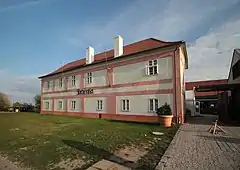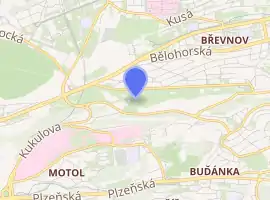Ladronka
Ladronka is a homestead at Tomanova 1028/1 in Prague 6, in the Czech Republic. Built by Charles IV, it was bought by an Italian count, then owned by the Sovereign Military Order of Malta before being broken into flats during communism. It was then squatted in 1993, becoming an internationally famous anarchist, self-managed social centre which was evicted in 2000. After several years of renovation, Ladronka was re-opened as an activities centre in 2005, to serve the park it sits within. There are facilities for dining, cycling, rollerskating, beach volleyball and football.
| Ladronka | |
|---|---|
 Ladronka in 2019 | |

| |
| General information | |
| Status | Formerly vineyard, flats and self-managed social centre, now activities centre |
| Type | Homestead |
| Address | Tomanova 1028/1 |
| Town or city | Prague |
| Country | Czech Republic |
| Coordinates | |
| Renovation cost | 80 million crowns |
History
Ladronka was built as a homestead by Charles IV, Holy Roman Emperor in 1340. It was a vineyard and stopping point on the road to Karlštejn castle.[1] An Italian nobleman, the Count Filip Ferdinand de la Crone (or Lacrone), bought the farm in 1688 and it came to be known as Ladronka in a Czech mispronunciation of his name.[2] Ladronka was subsequently owned by the Sovereign Military Order of Malta, then divided into flats under communism. After the Velvet Revolution it stood derelict and was squatted.[1]
Self-managed social centre
Ladronka was occupied by anarchists in 1993 and became a self-managed social centre.[3] Among the people living there was rapper Vladimír 518.[4] The squatters organised events such as gigs, exhibitions, readings and theatre, also publishing the magazine Autonomie.[2]
The first police raid came in February 1994 and the squatters mustered support with demonstrations and petitions. A year later in January 1995, a large police raid searched the entire building and arrested eight squatters. The squat was not evicted but there were plans to turn the building into a hotel, so the squatters mobilised support again. At a public meeting, local people voiced their opposition to the development plans.[5] An eviction date had been set and on the day the squatters symbolically handed over a paper model of the building to the municipality and continued the occupation.[5]
The social centre became internationally famous as a hub for counter-cultural activities and anarchist organisation. The squatters formed the Ladronka Foundation and successfully negotiated with the city of Prague to legalise the occupation.[6] By the late 1990s, the focus of the centre was shifting from politics to cultural activities, as part of a general downturn in anarchist activity in the Czech Republic.[6]
By this time, the city had signed a contract with the Santé group which planned to develop Ladronka into a luxury medical centre.[2] The social centre was evicted on 9 November 2000 by private security and police as part of a moral panic following the anti-globalization protests in Prague.[7][6] The eviction was not mandated by any juridical decision.[8]
Activities centre
After Ladronka was evicted, it was used as a training facility for police dog handlers. Reconstruction plans were delayed by various factors such as the floods in 2002 and the discovery of archaeological remains on the site. Since the park surrounding the building, now known as Ladronka Park, was used for recreation, a plan was devised to use the Ladronka homestead as an activities centre.[9]
At a cost of 80 million crowns, born by Prague 6 and the city of Prague, Ladronka was renovated. It now houses facilities for cycling, rollerskating and other sports. Equipment can be hired and there is a restaurant. Later, beach volleyball and football courts were added.[1] It was opened in September 2005, marking the 85th anniversary of Prague 6. The following year, the centre was nominated for Building of the Year, as decided by the ABF foundation.[2] The leisure centre is rented from Prague 6 by Ladronka s.r.o. and is located at Tomanova 1028/1 in the Břevnov district of Prague 6.[10]
See also
References
- Horáková, Pavla (16 November 2011). "Prague's Ladronka park offers something for everybody". Radio Prague International. Retrieved 28 September 2020.
- Eichler, Pavel (21 August 2006). "Bývalý squat Ladronka bojuje o titul Stavba roku". iDNES. Retrieved 28 September 2020.
- Pixová, Michaela (15 November 2019). Contested Czech Cities: From Urban Grassroots to Pro-democratic Populism. Springer Nature. p. 94. ISBN 978-981-329-709-8. Retrieved 28 September 2020.
- Bernáth, Nikolas (18 December 2017). "I just do what I want and I'm a kid in a candy shop. Vladimír 518". The Invisible Mag. Retrieved 28 September 2020.
- Trnka, Jan; Novák, Arnošt (2018). "Squatting in Prague". In Squatting Everywhere Kollective (ed.). Fighting for spaces, fighting for our lives: Squatting movements today (1 ed.). Münster: edition assemblage. pp. 151–166. ISBN 9783942885904.
- Novák, Arnošt; Pixová, Michaela. "Prague Post-1989: Boom, decline and renaissance" (PDF). Baltic Worlds.
- Steen, Bart van der (September 2014). The City Is Ours: Squatting and Autonomous Movements in Europe from the 1970s to the Present. PM Press. p. 249. ISBN 978-1-60486-683-4. Retrieved 28 September 2020.
- Novák, Arnošt; Kuřík, Bob (17 February 2020). "Rethinking radical activism: Heterogeneity and dynamics of political squatting in Prague after 1989". Journal of Urban Affairs. 42 (2): 203–221. doi:10.1080/07352166.2019.1565820. S2CID 159082940.
- "Současná Ladronka, Ladronka – server o in-line bruslení". www.ladronka.cz. Retrieved 28 September 2020.
- "O nás, Ladronka – server o in-line bruslení". www.ladronka.cz. Retrieved 28 September 2020.
Statek Ladronka má od městské části Praha 6 v pronájmu soukromá firma Ladronka s.r.o